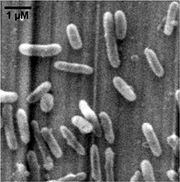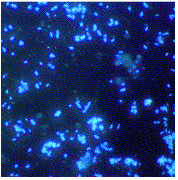Thiobacillus denitrificans
Classification

Species
Description and Significance
Thiobacillus denitrificans is short rod-shaped (0.5×1.0-3.0 um), Gram-negative, obligately chemolithoautotrophic, and a member of the beta- subclass of the Proteobacteria. Different from many known chemolithotrophic sulfur-oxidizing bacteria (such as Acidithiobacillus ferrooxidans) which are strictly aerobic, T. denitrificans grows as a facultatively anaerobic chemolithotroph, coupling the oxidation of inorganic sulfur compounds to the reduction of nitrate, nitrite and other oxidized nitrogen compounds to dinitrogen. The optimum conditions for denitrification are pH 6.85 at 32.8°C, while the optimal growth conditions are pH 6.90 at 29.5°C. Found in soil, mud, freshwater- and marine sediments and also in domestic sewage and industrial waste-treatment lagoons and digestion tanks, especially under anoxic conditions.
T. denitrificans can remediate natural groundwater and engineered water treatment systems by removing excess nitrate. It is the first and only autotrophic bacterium reported to carry out anaerobic (nitrate-dependent) oxidation of U(IV) oxide minerals, which could partially counteract efforts to remediate uranium contaminated aquifers by in situ reductive immobilization
T. denitrificans is one of the best studied of the very few obligately chemolithoautotrophic species which can couple denitrification with sulfur-compound oxidation.
Genome Structure

Cell Structure, Metabolism and Life Cycle

The cells may be motile through a polar flagellum. Clear or weakly opalescent colonies are grown anaerobiclally on thiosulfate/nitrate agar, which upon aging may become white with sulfur. Growth in anaerobic stab- or roll culture results in agar splitting due to production of nitrogen gas.
T. denitrificans grows slowly with no apparent stable phase. The maximal denitrification rate reached 2.245 mg/(L-h), which is found in exponential phase. In the process of the culture, the medium pH decreases significantly. Relatively high salinity restrains the denitrification activity of T. denitrificans. The acute toxicity test results show that T. denitrificans is not toxic.
T. denitrificans grows aerobically on thiosulfate, tetrathionate and thiocyanate; it also grows anaerobically on thiosulfate, tetrathionate, thiocyanate, sulfide or elemental sulfur.
2NO3- + S + H2O + CaCO3 --> CaSO4 + N2
Previous chemical equation represents one of the typical reactions coupling the oxidation of inorganic sulfur compounds to the reduction of oxidized nitrogen compounds. The inorganic sulfur compounds provide electrons, while the oxidized nitrogen compounds behave has terminal respiratory oxidants. Ammonium salts and, in some strains at least, nitrate are used as nitrogen sources. There is evidence that in T. denitrificans, sulfide is oxidized by a series of reactions catalyzed by a sulfide/sulfite oxidoreductase similar to that found in some sulfate-reducing bacteria. The oxidation of elemental sulfur by T. denitrificans might be preceded by its initial reduction to sulfide, followed by oxidation to sulfite.
In addition, most electron donors that T. denitrificans can utilize are poorly-soluble minerals containing reduced iron and/or sulfur, such as pyrite (FeS2) and FeS. The mechanism by which this species can use solid-phase electron donors that cannot be taken into the cell is of considerable interest but is currently unknown.
Studies on fixation of carbon dioxide of T. denitrificans found that it is capable of synthesizing hexose phosphates from carbon dioxide by a cyclic mechanism similar to that found in green plants.
Batch cultures can be grown in completely filled bottles, producing vigorous nitrogen evolution. Chemostat culture can be switched easily and repeatedly between aerobic and anaerobic growth modes, with adaptation involving derepression of nitrate and nitrite reductase synthesis.
Ecology
Thiobacillus denitrificans is a widely distributed bacterium, found in both soil and water habitats. In artificial habitats, Thiobacillus denitrificans is considered easily culturable, and was first cultured by Beijerinck in 1904. The variety of habitats occupied by thiobacillus denitrificans include: pond water, brackish mud, soil, marine sediment, sewage lagoons, digestion tanks, and even abandoned mines. The ideal temperature and pH for growth is 28-32 degrees Celsius and 6.8-7.4, respectively. Although Thiobacillus denitrificans is an anaerobic organism, it can live under aerobic conditions.
There is an interest in Thiobacillus denitrificans for environmental remediation, particularly for nitrate removal. Excess nitrogen can cause problems such as eutrophication and methemoglobinemia (blue baby syndrome), and is caused primarily by discharge of waste waters and overuse of fertilizers. Heterotrophic denitrifiers have traditionally been favored, but Thiobacillus denitrificans may be a good alternative. Thiobacillus denitrificans is an autrophic denitrifier, which has the competitive advantages of not needing an external carbon source to be added to the process, and not producing as much sludge. Sulfur-based systems that T. denitrficans thrive in have been considered as a viable solution to remove nitrate from groundwater and surface water that have been contaminated, as well as remediating waste waters with high nitrate levels such as nitrified leachate. Experimental data supports T. denitrificans as efficient in nitrate removal in the long term, and as a dominant species in nitrate removal in a wide variety of applications. Thiobacillus denitrificans is able to reduce not only nitrate, but nitrite as well.
Thiobacillus denitrificans is also being considered for sulfide removal. Sulfur compounds in the environment are undesirable due to their toxicity, unpleasant smell, corrosive properties, and high oxygen demand. Complete sulfur removal is attained by partial oxidation of sulfide to elemental sulfur followed by phase separation. Aerobic sulfide oxidation is the preferred method for removing sulfide in industrial wastewater, but if both nitrate and sulfide are present, such as is common in the food industry, autotrophic denitrification is favored. The sulfide/nitrate ratio for T. denitrificans may be manipulated control to the fate of sulfide oxidation to either elemental sulfur or sulfate. There is a concern about trace metals and sulfate produced in the sulfide oxidation of Thiobacillus denitrificans, as the oxidation may lead to increased heavy metal motility and toxicity potential, and sulfate may contribute to eutrophication.
In a study of hard coal mining sites in Germany, a high abundance of Thiobacillus denitrificans was found at all sites. In the superficial dump layers of the mining sites, Thiobacillus denitrificans consumed the excess nitrate. Thiobacillus denitrificans was also found in abundance at a constructed wetland for treating mining pollution.
Thiobacillus denitrificans-like (95-96% similarity) organisms have been shown to oxidize U(IV) in the presence of nitrate. These organisms favored growth on the sediment of such contaminated areas, and were associated as playing a large role in bio-oxidation in the remediation process.
References
- Kelly, D.P., A.P. Wood, 2000. Confirmation of Thiobacillus denitrificans as a species of the genus Thiobacillus, in the beta-subclass of the Proteobacteria, with strain NCIMB 9548 as the type strain. International Journal of Systematic and Evolutionary Microbiology, 50:547-440
- Shao, M., T. Zhang, H.H. Fang, 2010. Sulfur-driven autotrophic denitrification: diversity, biochemistry, and engineering applications. Applied Microbiology and Biotechnology, 88 (5):1027-1042
- Karyn’s Genomes, European Bioinfomatics Institute.
- Lengeler, J.W., G. Drews, H.G. Schlegel, 1999. Oxidation of Inorganic Compounds by Chemolithotrophs. Biology of the prokaryotes, 10:234-260. [ISBN 3-13-108411-1]
- Genome of Thiobacillus denitrificans ATCC 25259
- Beller, H.R., P.S.G. Chain, T.E. Letain, A. Chakicherla, F.W. Larimer, P.M. Richardson, M. Coleman, A.P. Wood, and D.P. Kelly, 2006. The genome sequence of the obligately chemolithoautotrophic, facultatively anaerobic bacterium Thiobacillus denitrificans. The Journal of Bacteriology. 188:1473-1488.
Authors
Page authored by Emily Campbell and Rui Chen, students of Prof. Jay Lennon at Michigan State University.
